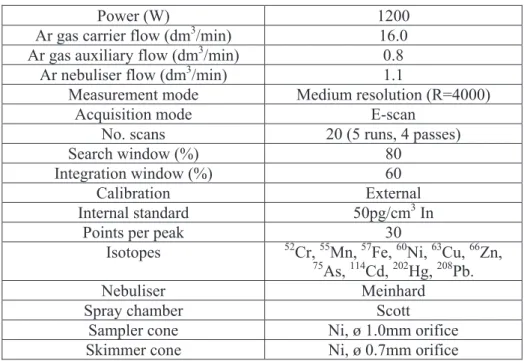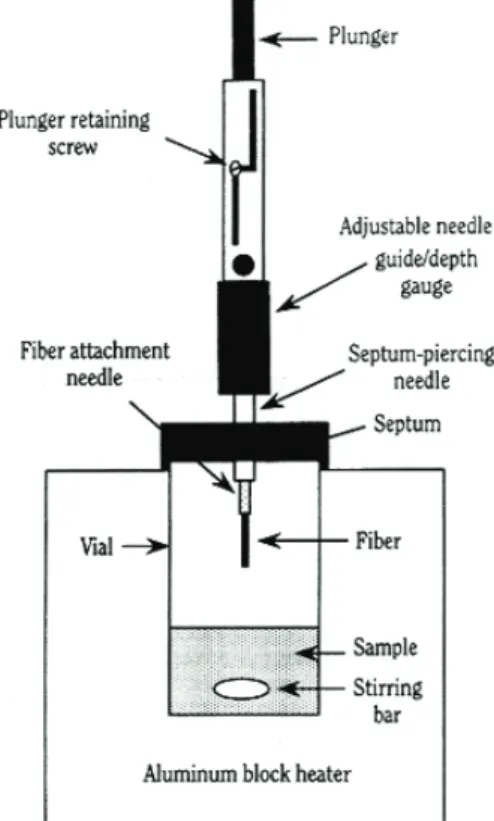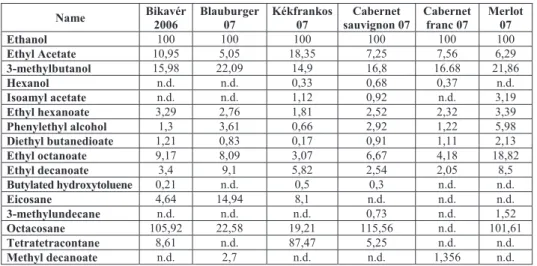Comparison of trace element and aroma compound contents of red wines
Csaba Csutorás
1– László Rácz
1– Gyula Záray
21Chemistry Department of Eszterházy Károly College, Eger, Hungary H-3300 Eger, Leányka Str. 6.
2Eötvös Loránd University, H-1117 Budapest, Hungary.
Abstract: Vörösborok nyomelem és aroma-anyag tartalmának összeha- sonlítása. A bor minĘségét különbözĘ tényezĘk határozzák meg. A talaj, a klí- ma, a technológia és a szĘlĘfajta, mind jelentĘs hatással van a bor összetételére és belsĘ értékére. Vizsgálatainkba ugyanarról a területrĘl származó 5 féle vörös- bort vontunk be: 2007-es évjáratú blauburgert, kékfrankost, cabernet-savignont, merlot-t és 2006-os bikavér cuvee-t. A nyomelemek koncentrációját mikrohul- lámú savas erjesztést követĘ plazma-tömegspektrometriával határoztuk meg, továbbá 16 aroma-vegyületet határoztunk meg a szilárd fazes kivonását követĘ GC-MS módszerrel. A nyomelem-tartalom gyakorlatilag nem függött a szĘlĘfaj- tától, az aroma-anyagok azonban – különösen a tetratetrakontán, az oktanoszán és az etil-oktanoát esetén – jelentĘs különbségeket mutattak.
Introduction
Egri Bikavér (Bull’s Blood of Eger) is a traditional red cuvee wine originated from the Northern Hungarian Wine-growing Region of Hungary [1, 2]. It is made from various blue grapes (Blauburger, Kékfrankos, Cabernet sauvignon, Cabernet franc, Merlot) under strict regulations of origin-protection. Bull’s Blood of Eger is well known and consumed not only in Hungary but in various countries of Europe and the world. The quality assurance of wines needs well defined investigations e. g. determination of ethyl alcohol or sugar content, con- centration of different organic acids and color compounds etc. [3]. However from toxicological point of view it is recommended to check the concentrations of toxic heavy metals originating from soil, fertilizers, pesticides or herbicides [4]. The trace element content of wines remains practically constant during sto- rage, however aroma compounds change continuously. Concentrations of certain groups of primary aroma compounds coming from grapes and the fermentation
aroma compounds decrease during the maturation of wines. In the case of oxida- tive treatment mostly aldehydes and acetates are formed, while the application of reductive technology results in the formation of higher ester content. In this pa- per we studied the influence of the variety of grapes on the concentration of trace elements and aroma compounds in 6 red wines by applying Inductively Coupled Plasma Sector Field Mass Spectrometer (ICP-SF-MS) and Solid Phase Micro Extraction / Gas Chromatograph Mass Spectrometer (SPME/GC-MS) techniques, respectively. For determination of trace elements an Element2 ICP- SF-MS (Thermo Finnigan, Germany) was used. The operating conditions of this equipment are summarized in Table 1. Microwave-assisted digestion of wine samples was performed by using a Multiwave Paar Physica device (Paar, Aus- tria). For this procedure six HQ50 quartz bombs (Paar, Austria) were used si- multaneously.
Table 1. Operating conditions of ICP_SF_MS system
Power (W) 1200
Ar gas carrier flow (dm3/min) 16.0 Ar gas auxiliary flow (dm3/min) 0.8
Ar nebuliser flow (dm3/min) 1.1
Measurement mode Medium resolution (R=4000)
Acquisition mode E-scan
No. scans 20 (5 runs, 4 passes)
Search window (%) 80
Integration window (%) 60
Calibration External
Internal standard 50pg/cm3 In
Points per peak 30
Isotopes 52Cr, 55Mn, 57Fe, 60Ni, 63Cu, 66Zn,
75As, 114Cd, 202Hg, 208Pb.
Nebuliser Meinhard
Spray chamber Scott
Sampler cone Ni, ø 1.0mm orifice
Skimmer cone Ni, ø 0.7mm orifice
Experimental
Trace element analysis Reagents and standards
Suprapure 65% HNO3 (Merck, Germany) was used for the microwave- assisted digestion of wine samples. For tuning and mass calibration of ICP-SF- MS instrument an acidic (5% HNO3) Merck Multi-element standard solution in concentration of 1ng/cm3 for each element was employed. For internal standar- dization acidic indium (Merck) stock solutions (0.5 mol/dm3 HNO3) were pre- pared daily from their stock solutions by appropriate dilution with ion- exchanged water. The final HNO3 concentration of the solutions was 5%.
Analytical procedure
For trace element analysis aliquots of 2cm3 wine samples filtered through Millex PDVF filters of 0.2ȝm pore size were placed into quartz bombs. Aliquots of 2cm3 HNO3 were carefully added. The samples were subjected to microwave- assisted digestion for 40 min, at 1000W (nominal power value per six bombs) achieved with a ramp of 50W/min. Six bombs were used simultaneously for one digestion procedure. Between two digestions the bombs were cleaned with 5cm3 HNO3 (Suprapure) at 1000W, for 20 min. The purity of the resulting solutions was checked by ICP-SF-MS method. After digestion indium internal standard was added and the solutions were filled up to 40cm3 with deionized water. These solutions were analyzed by ICP-SF-MS technique applying external calibration.
Determination of aroma compounds
Aroma compounds were adsorbed on a quartz fiber covered with poly- dimethylsiloxane (100ȝm PDMS, non-polar). The fiber was introduced into 5cm3 vapor space above 100cm3 wine sample, at room temperature (Fig. 1.).
Fig. 1. SPME set up for measurement of aroma compounds
The contact time amounted to 15 min. In order to achieve the balance be- tween the liquid and vapor phases, wine was stirred in closed vessel for 20 min, before the introduction of the fiber. After pre-concentration of aroma compounds the loaded fiber was put into a heated injector (220oC) of the GC-MS system (Shimadzu QP 2010S) and analyzed after separation on HP-5MS (30m×0.25mm×0.25ȝm) column. The analytical signals of aroma compounds were related to the signal of ethyl alcohol.
Results and discussion
Five different wines of blue grape varieties (Blauburger, Kékfrankos, Caber- net sauvignon, Cabernet franc, Merlot) of the same year (2007) and of the same terroir and also a Bikavér wine of 2006 coming from the same terroir, made from the same varieties of red wines using the same technology, were involved in our examination.
The concentration of toxic trace elements (Cd, Hg, As, Pb) is negligible. The other elements have similar concentration, which means, that the variety of grapes has no significant influence on their uptake processes (Table 2.).
Table 2. Concentrations (ȝg/cm3) of trace elements in investigated red wines. Standard deviation data are calculated on the basis of the subsequent integrations within one run
(n=20). Limits of quantification were calculated as 10 sigma.
1995/90th jur. 27§. 11th paragraph
Cabernet franc
07 Blauburger 07 Merlot 07 Cabernet
Sauvignon 07 Kékfrankos 07 Bikavér 06 Limit values *
Cr 0.032±0.001 0.023±0.001 0.031±0.001 0.029±0.001 0.043±0.001 0.041±0.001 -
Mn 1.94±0.09 1.90±0.06 3.15±0.09 1.89±0.08 2.14±0.09 2.36±0.10 -
Fe 1.67±0.03 3.89±0.12 2.89±0.10 3.10±0.15 3.60±0.22 2.28±0.06 5
Ni 0.082±0.002 0.095±0.002 0.111±0.004 0.086±0.002 0.091±0.003 0.084±0.002 -
Cu 0.168±0.009 0.008±0.001 0.106±0.003 0.035±0.002 0.029±0.001 0.069±0.003 10
Zn 1.07±0.02 0.859±0.016 0.787±0.032 0.877±0.019 1.45±0.03 0.712±0.023 10
Pb 0.0075±0.0008 0.0037±0.0001 0.0043±0.0001 0.0037±0.0001 0.0070±0.0001 0.0032±0.0001 0.25
As <0.065 <0.065 <0.065 <0.065 <0.065 <0.065 0.1
Cd <0.010 <0.010 <0.010 <0.010 <0.010 <0.010 0.02
Hg <0.002 <0.002 <0.002 <0.002 <0.002 <0.002 0.01
The analytical signals of 16 identified aroma compounds were related to the signal of ethyl alcohol (Table 3.).
Table 3. Analytical signal of aroma compounds related to ethyl alcohol signals meas- ured in vapor phase by GC-MS method.
Name Bikavér
2006
Blauburger 07
Kékfrankos 07
Cabernet sauvignon 07
Cabernet franc 07
Merlot 07
Ethanol 100 100 100 100 100 100
Ethyl Acetate 10,95 5,05 18,35 7,25 7,56 6,29
3-methylbutanol 15,98 22,09 14,9 16,8 16.68 21,86
Hexanol n.d. n.d. 0,33 0,68 0,37 n.d.
Isoamyl acetate n.d. n.d. 1,12 0,92 n.d. 3,19
Ethyl hexanoate 3,29 2,76 1,81 2,52 2,32 3,39
Phenylethyl alcohol 1,3 3,61 0,66 2,92 1,22 5,98
Diethyl butanedioate 1,21 0,83 0,17 0,91 1,11 2,13
Ethyl octanoate 9,17 8,09 3,07 6,67 4,18 18,82
Ethyl decanoate 3,4 9,1 5,82 2,54 2,05 8,5
Butylated hydroxytoluene 0,21 n.d. 0,5 0,3 n.d. n.d.
Eicosane 4,64 14,94 8,1 n.d. n.d. n.d.
3-methylundecane n.d. n.d. n.d. 0,73 n.d. 1,52
Octacosane 105,92 22,58 19,21 115,56 n.d. 101,61
Tetratetracontane 8,61 n.d. 87,47 5,25 n.d. n.d.
Methyl decanoate n.d. 2,7 n.d. n.d. 1,356 n.d.
n.d. not detectable
ethanol ethyl acetate 3-methylbutanol hexanol isoamyl acetate ethyl hexanoate phenylethyl alcohol diethyl butanedioate ethyl octanoate ethyl decanoate butylated hydroxytoluene eicosane 3-methylundecane octacosane tetratetracontane methyl decanoate 0
50 100 150
Blauburger 07 Cab. Franc 07 Bull's Blood 06 Kékfrankos 07 Merlot 07 Cab. Sauv. 07
Fig. 2. Analytical signals of aroma compounds related to ethyl alcohol signals measured in vapor phase after SPME by GC-MS
These data demonstrate that the dominant aroma compounds are octacosane, tetratetracontane, isoamyl alcohol, ethyl octanoate and ethyl acetate. In the case of Bull’s Blood, Blauburger, Cabernet Sauvignon and Merlot wines octacosane had the highest concentration, while in the case of Kékfrankos and Cabernet franc tetratetracontane and isoamyl alcohol are the dominant aroma compounds, respectively (Fig. 2.).
References
1. Eperjesi I. – Kállay M. – Magyar I.: Viniculture. MezĘgazda Kiadó, Budapest, 1998.
2. Szarvas J. – Hajdú Cs. – Kliegl D. – Rácz L.: Hungarian fermentation yields in winemaking. „Fermentators” Élet és tudomány (2005/42.), 1318–1320.
3. Kiss A. – Csutorás Cs. – Bóka B.: Az Egri Bikavér eredetvédelmével kapcsolatos pH-potenciometriás vizsgálatok és új paraméterek kifejlesztése. Acta Acad.
Paed. Agriensis, Sectio Chemiae XXXI. 2004, 37–41.
4. Kiss, A. – Rapi, S. – Csutoras, Cs.: GC/MS studies on revealing products and reaction mechanism of photodegradation of pesticides. Microchem. J. 2007, 85(1), 13.



